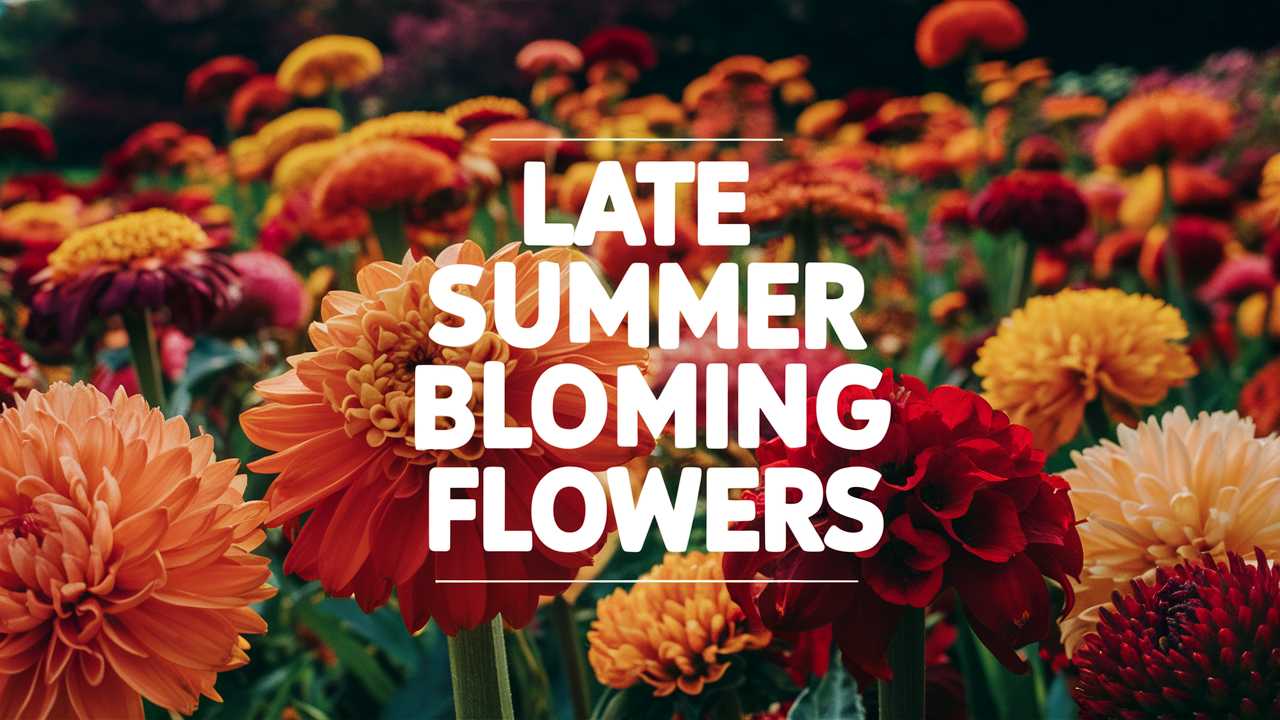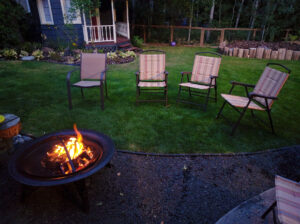Let’s explore some of the most stunning late summer blooming flowers to keep the spirit of summer alive.
Coneflower
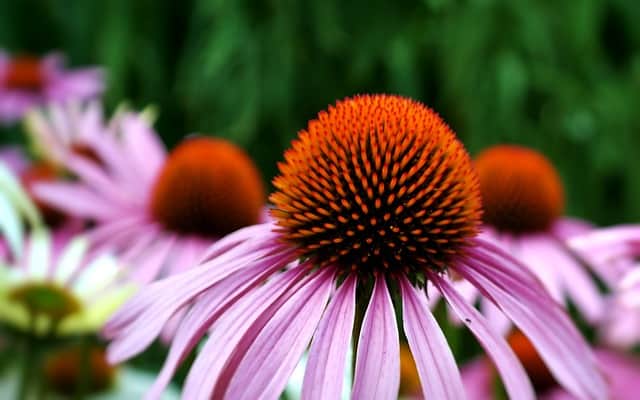
Coneflowers, or Echinacea, are commonly celebrated for their striking daisy-like appearance and ability to thrive in a variety of conditions. Blooming from mid-summer to early fall, these hardy perennials offer vibrant pink, purple, and white hues that dance in the warm breezes. One of their most appealing traits is their aptitude for attracting pollinators, notably bees and butterflies, which makes them a garden favorite.
Coneflowers are also highly resilient, thriving in poor, dry soils where other flowers might struggle. They prefer full sun and are drought-resistant once established. This makes them perfect for low-maintenance gardens. Furthermore, they are not just visually stunning; their medicinal properties are well-known, having been utilized for centuries by Native Americans for various ailments. With minimal care, these flowers can last for years, adding consistent beauty to your garden.
Rudbeckia
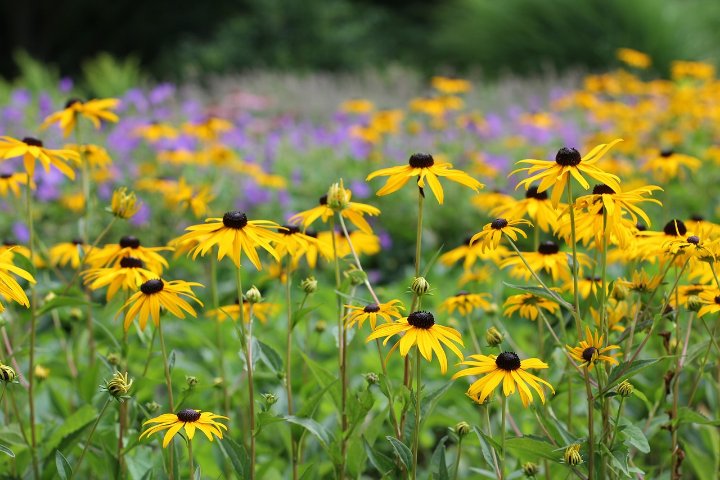
Rudbeckia, more commonly referred to as black-eyed Susans, is synonymous with sunny summer days. Their vibrant yellow petals and dark brown centers provide a cheerful display that lasts from summer into early fall. These flowers are infamous for their ability to thrive in diverse environments, enduring droughts and poor soils with ease.
In addition to their beauty, black-eyed Susans are hardy perennials that reproduce effortlessly, often self-seeding in favorable conditions. This means that with a little patience, they can populate your garden organically year after year. Their long-lasting blooms are perfect for fresh-cut floral arrangements, effectively brightening up interiors. Overall, Rudbeckia provides an excellent way to channel summer’s joy straight into autumn, energizing any garden space.
Phlox
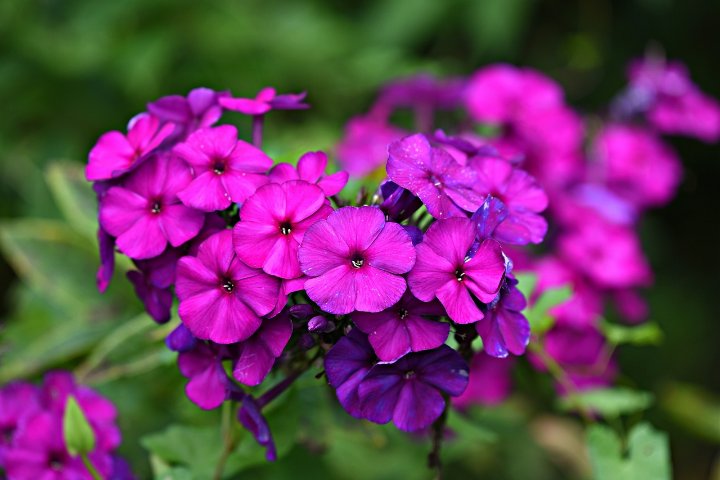
Phlox is an incredible flower group consisting of both annual and perennial varieties, known for their clusters of fragrant blooms. Late summer bloomers like Phlox paniculata are particularly prized for their vibrant hues ranging from soft pastels to bold, bright colors. These flowers thrive in full sun and well-drained soil, making them versatile staples in cottage gardens.
One of the most lovable characteristics of phlox is their rich fragrance. They are a magnet for butterflies and hummingbirds, creating a lively atmosphere in the garden. Regular deadheading encourages more blooms, prolonging the flower’s life. With various cultivars available, gardeners can play with heights and colors, creating vibrant displays that will attract visitors – both human and pollinator – throughout the warm months.
Asters
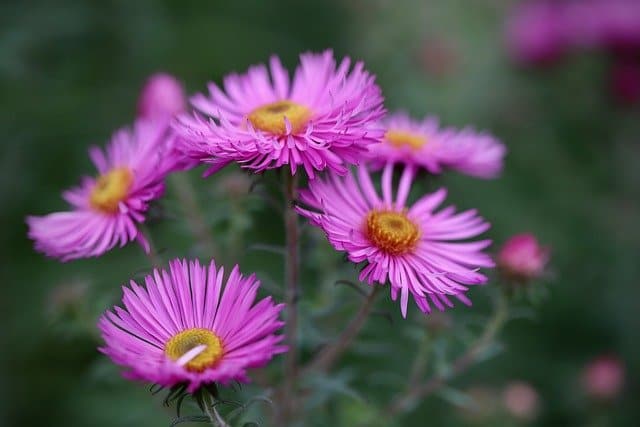
As summer wanes, asters step in to bridge the gap between the fleeting summer blooms and the autumnal colors. Asters provide an explosion of color in shades of blue, purple, pink, and white, often resembling daisies. Blooming as late as October, their unusually resilient nature helps them maintain their beauty long after many other flowers have faded.
These perennial flowers are favorites in perennial borders and wildflower gardens, thriving in poor soil and adapting to different light conditions. Their capacity to attract various pollinators, including bees and butterflies, adds to their allure. Asters are also known for their ability to spread, making them excellent ground cover if planted in larger swathes. They wrap up summer’s floral fiesta with grace, often serving as a backdrop for the autumn harvest.
Snapdragons
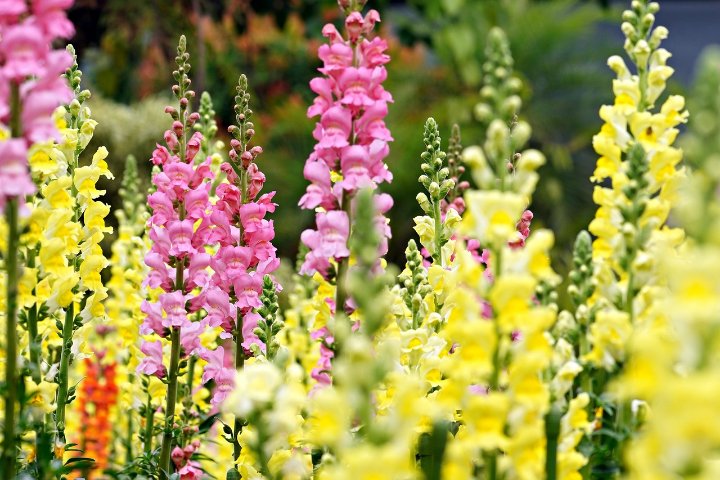
Though typically seen as spring’s flower, snapdragons have an underrated ability to bloom from late summer into fall when planted for continuous blooms. Known for their unique, dragon-shaped blossoms, these annuals add vertical height and cheerful colors to gardens. They come in an array of colors, from pastel pinks to bold reds and oranges, offering many options for floral arrangements.
Snapdragons prefer cooler temperatures for optimal growth, making them perfect for late summer when the heat begins to wane. Regular watering and deadheading stimulate new growth, ensuring a beautiful show of flowers long after other blooms have faded. Their charming nature appeals not only to gardeners but also to bees and butterflies, turning your garden into a thriving ecosystem during the late summer months.
Panicle Hydrangea

Panicle hydrangeas (Hydrangea paniculata) are late-blooming shrubs that bring a sculptural element to any landscape. Characterized by their large, conical flower heads, which shift from creamy white to shades of pink as they mature, these hydrangeas stand out beautifully against a backdrop of lush greenery. They are amongst the most cold-hardy hydrangea varieties, thriving in zones 3 to 8 and providing reliable blooms every year.
These hydrangeas excel in well-drained soils and full sun or partial shade, which allows them to reach their maximum growth potential. They can be shaped into manageable sizes through pruning, and their blooms can be dried for winter arrangements, offering a continued decorative appeal even after the growing season. Panicle hydrangeas are perfect for creating striking focal points in the garden, incorporating elegance and grace without requiring an extensive care regimen.
Leadwort
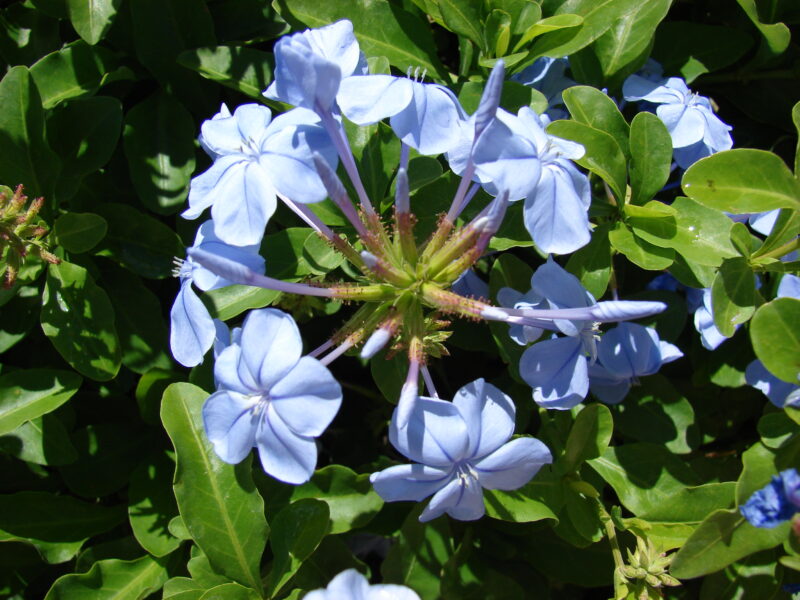
Leadwort, or Ceratostigma, is a lesser-known gem among late summer bloomers. With its beautiful blue flowers and vibrant autumn foliage, this perennial is charming in gardens as a ground cover or in mixed borders. Blooming from late summer through fall, its delicate blossoms are complemented by stunning crimson and orange leaves as the season progresses.
Leadwort thrives in full sun to partial shade and prefers well-drained soil, which allows it to flourish with minimal maintenance. It is especially valued for its ability to spread and fill in bare spots without becoming overly invasive. The contrast of its blue flowers against the warm autumnal leaves creates a delightful visual spectacle, making it an often-overlooked treasure that any gardener would be enthusiastic about exploring.
Chrysanthemums

Chrysanthemums, commonly known as mums, are a staple of late summer that transitions beautifully into autumn gardens. Their blooms come in a variety of colors, sizes, and shapes, making them versatile additions that can elevate any garden design. Mums typically blossom from late summer into fall, filling gardens with eye-catching bursts of yellow, orange, purple, and white.
These hardy perennials thrive when planted in well-draining soil and sunny spots. Not only are they eye-catching, but they also provide sustenance for pollinators in the late blooming season, attracting bees and butterflies eagerly. Additionally, chrysanthemums are often associated with the changing seasons, symbolizing joy and optimism, making them the perfect addition to celebrate the late summer transition into autumn.
Sedum
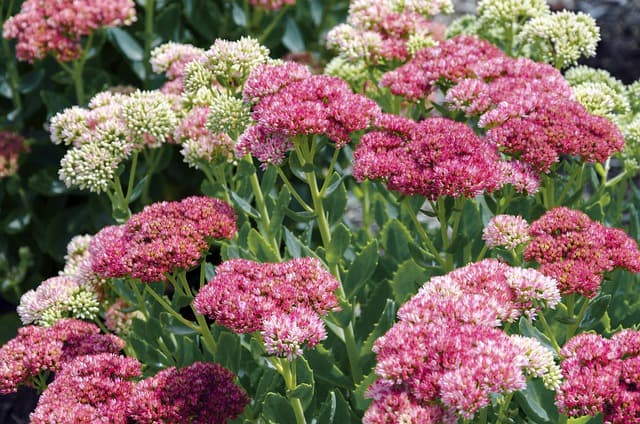
Sedum, commonly known as stonecrop, consists of a vast array of succulent plants that flourish in adverse conditions and require minimal care. These late summer bloomers often exhibit clusters of star-shaped flowers atop fleshy, green leaves that may vary in color. Their blooms range from soft pinks to bold reds, creating a beautiful contrast as summer gives way to autumn.
Sedums thrive in full sun and well-drained soils, making them ideal for rock gardens, borders, or container arrangements. Their drought resistance is a valuable trait, particularly in hot climates or during dry spells. Flowering late in the season, sedums attract assorted pollinators and birds, adding a lively energy to the garden. Additionally, their unique shapes and textures offer visual diversity throughout late summer into fall, creating lasting interest.
Dianthus
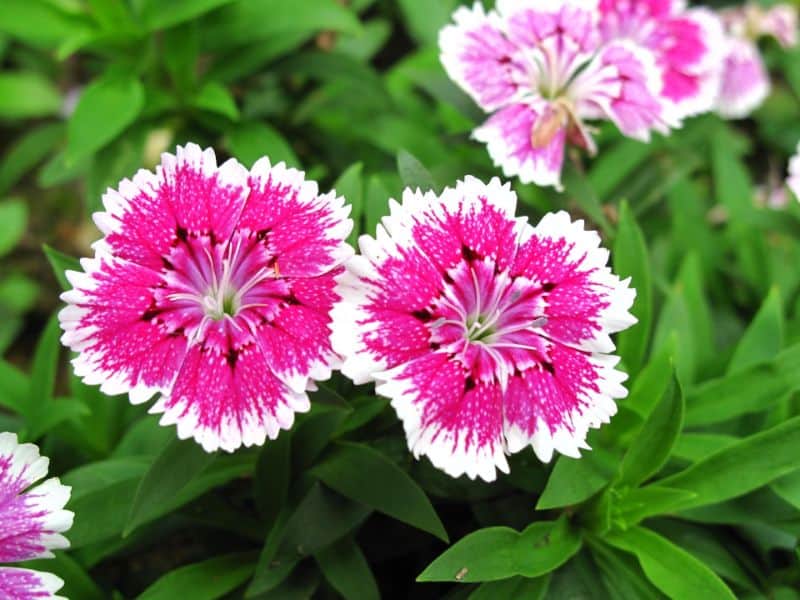
Dianthus, often referred to as pinks or carnations, brings an elegant charm to late summer gardens. Known for their frilled, ruffled blooms in various colors, these delightful flowers emit a sweet, spicy fragrance. They are perfect for border plantings or as accents in containers, with blooms that typically appear from late summer into early fall.
These adaptable perennials thrive in well-drained soils and prefer full sun to partial shade, establishing themselves easily in various conditions. Dianthus has a remarkable ability to repeat bloom, offering a continuous display of flowers throughout its growing season. Their low and spreading habit allows them to fill empty spaces effectively, creating a romantic ambiance in gardens as summer transitions into fall.
Dahlia
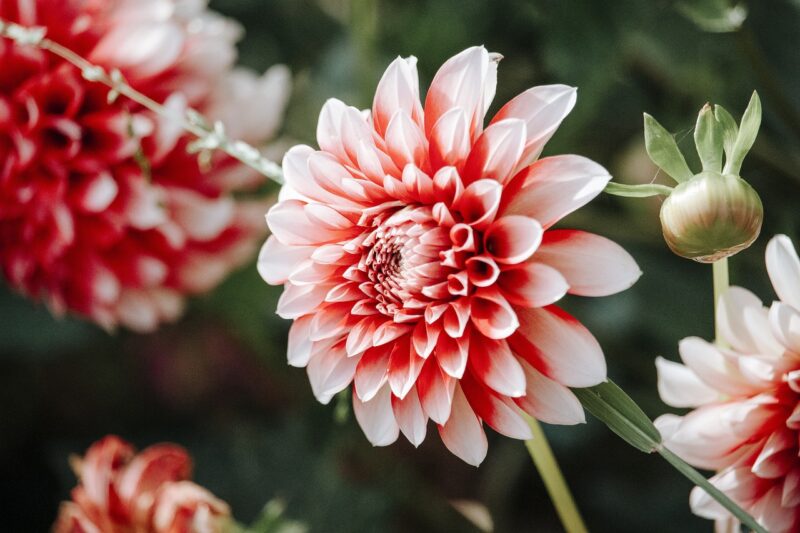
Dahlias are the stars of late summer gardens, showcasing extravagant blooms in every imaginable color, shape, and size. With a blooming period that often spans from midsummer into frost, dahlias provide endless opportunities for enjoyment and creativity in garden design. Their captivating flowers can be used for cutting, displaying beautiful arrangements that can brighten any interior.
These tuberous perennials prefer full sun and well-drained soil, requiring an attentive approach for optimal growth. Gardeners often delight in choosing from an impressive array of varieties, with options varying from simple single-flower types to complex and ornate forms. Dahlias also thrive when nurtured with regular watering and deadheading, ensuring a prolonged display through late summer. Their bold, blossoming presence makes them indispensable in capturing the essence of summer’s final flourish.
Japanese Anemone
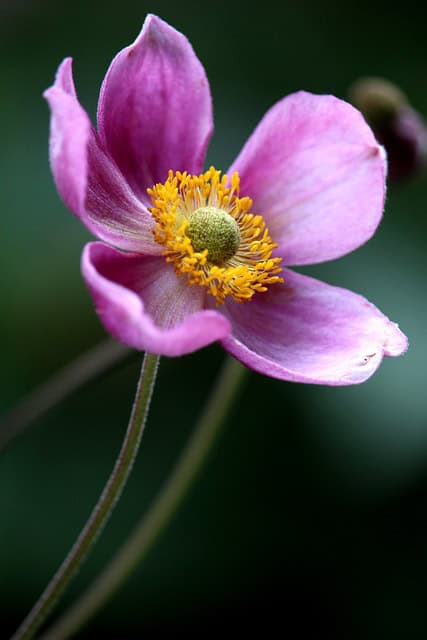
Japanese anemones bring an ethereal quality to late summer gardens, with delicate petals and graceful stems that sway gently in the breeze. They bloom from mid to late summer and into fall, producing flower clusters in shades of white, pink, and lavender. Their elegant appearance adds a touch of sophistication to any garden landscape.
These perennial flowers thrive in partial shade and moist, well-draining soil, making them perfect for woodland gardens or shady borders. They establish themselves robustly and typically spread gracefully, forming beautiful colonies over the years. Japanese anemones attract pollinators, such as bees and butterflies, making them valuable contributors to the local ecosystem. Their soft glow in the fading light encapsulates the fleeting beauty of late summer perfectly.
Joe Pye Weed
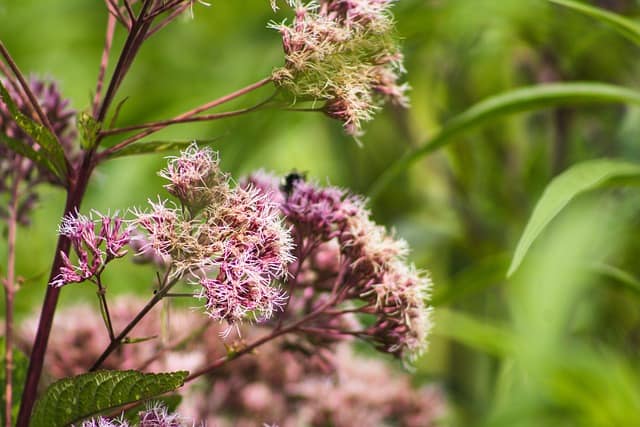
Joe Pye Weed (Eutrochium) stands tall and proud as a late summer bloomer, with towering flower spikes that can reach heights of up to 7 feet. Their fuzzy pink or purple blossoms attract a plethora of pollinators, including butterflies – a true testament to their ecological value. Joe Pye Weed often grows in wetland areas or along streams, making them suitable for rain gardens or edges of ponds.
These perennials thrive in full sun to partial shade, preferring moist but well-drained soils. Their hardy nature and ability to attract wildlife make them a popular choice for those wanting to enhance biodiversity in their gardens. Joe Pye Weed also offers natural structure to garden layouts, creating visual intrigue as its dramatic form towers above many other late bloomers. Its fragrance and aesthetic appeal make it a beautiful tribute to summer’s closure.
Cosmos
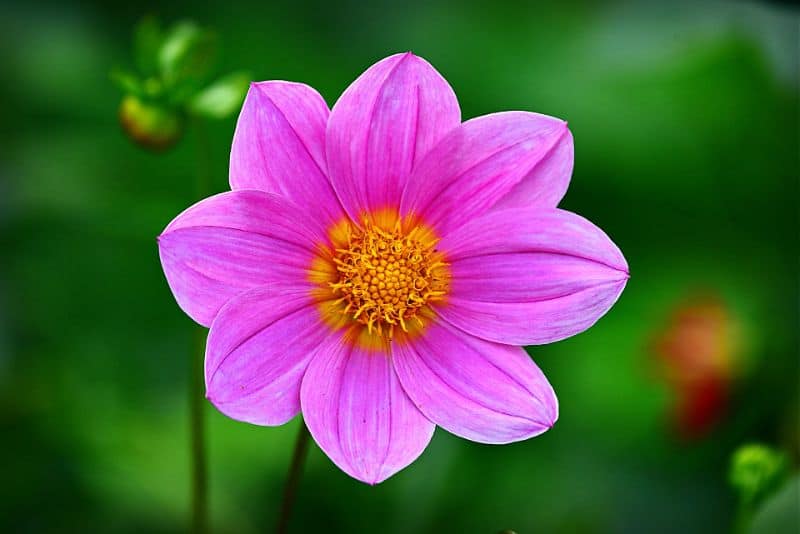
Cosmos are delightful annuals that bring warmth and joy to any late summer garden. Their simple daisy-like flowers bloom in a multitude of colors, including bright pinks, yellows, whites, and oranges. These floriferous beauties are easy to grow, making them a favorite among novice gardeners and seasoned horticulturists alike.
Giving a nod to their carefree nature, cosmos thrive in full sun and poor soils, making them perfect for garden areas that require minimal maintenance. They bloom over an extended period, from summer into fall, providing a cheerful burst of color as the season progresses. Their feathery foliage adds texture, while their long stems make them perfect for cutting. Planting cosmos ensures that your garden remains vibrant and inviting, welcoming pollinators and providing joy until the first frost.
Butterfly Bush
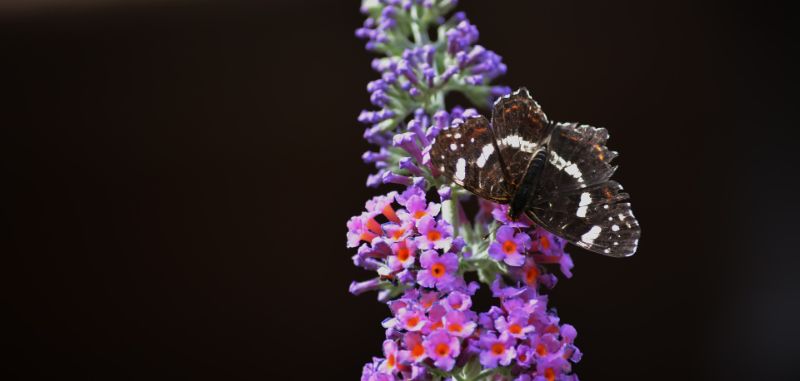
The butterfly bush (Buddleja) embodies the essence of a lively late summer garden, as it attracts various butterflies and hummingbirds with its fragrant, nectar-rich blooms. Available in multiple colors, including purple, pink, and white, these resilient shrubs can reach impressive heights and spread wide, making them both practical and visually striking.
Butterfly bushes prefer full sun and well-drained soils, ensuring they thrive in sunny garden spots. Their blooms appear from summer until frost, making them persistent performers in any landscape. The fragrant flowers not only delight the senses but also serve as vital sources of food for pollinators, reinforcing their importance as garden staples. By incorporating butterfly bushes into your landscape, you can support local wildlife while creating a stunning late summer vista.
Ageratum
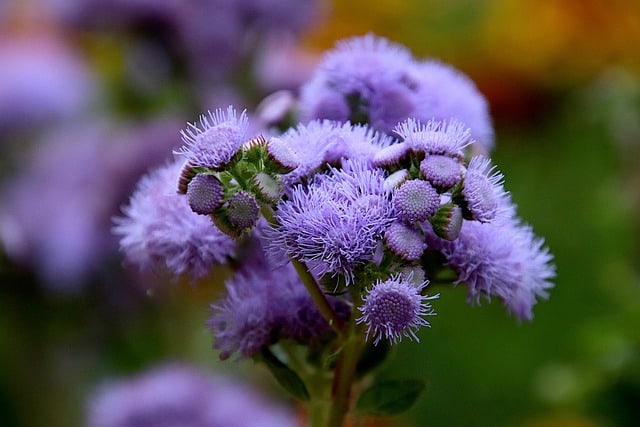
Ageratum, often referred to as floss flower, brings a soft touch to late summer gardens with its fluffy, pom-pom-like blooms that come in shades of blue, purple, and white. These annuals bloom from summer into fall, creating a delicate, colorful contrast against other late-blooming flowers.
Thriving in full to partial sun and well-drained soil, ageratums are adaptable plants suitable for containers, borders, or as ground covers. Their low and compact form provides significant color without overwhelming other garden inhabitants. Additionally, ageratums attract bees and butterflies, adding life and movement to gardens during the late summer months. Their ability to produce stunning blooms even in lower-quality soil makes them an attractive choice for easy-care gardening.
Calendula
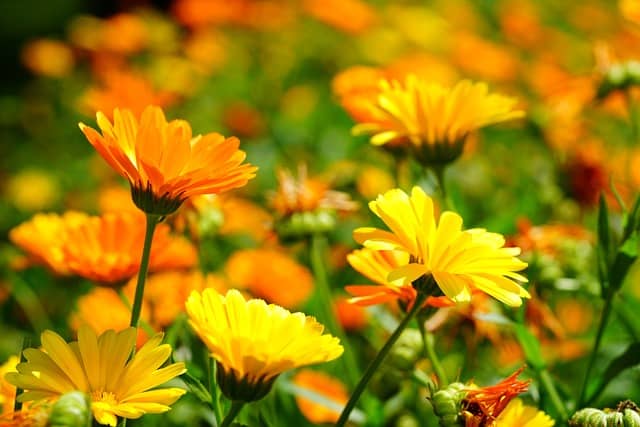
Calendula, commonly known as pot marigold, blooms with vibrant, cheerful flowers that serve as symbols of warmth and positivity. Though they can flower from early spring, these resilient annuals often bloom again in the late summer and early fall, offering delightful orange and yellow shades that brighten up any space.
These flowers thrive in a range of garden conditions, preferring full sun and well-drained soil. Calendula is not only beloved for its beauty but also valued for its healing properties; the petals can be used in salves and herbal remedies. Their gentle fragrance and attraction to pollinators make them an excellent option in vegetable gardens, as they can help draw beneficial insects. Incorporating calendula into your late summer display allows you to harness nature’s beauty while enjoying the benefits of its medicinal qualities.
Russian Sage
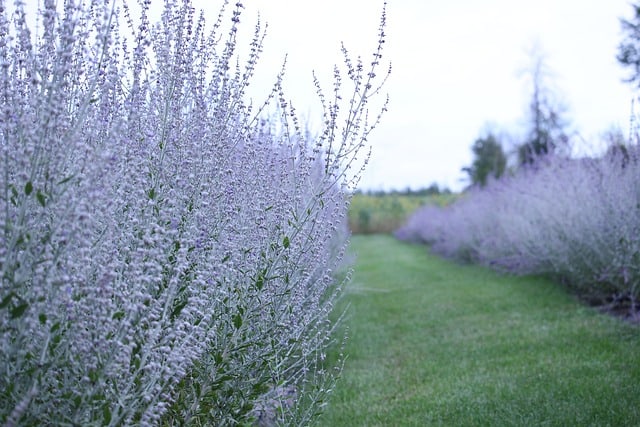
Russian sage (Perovskia atriplicifolia) brings a soft, silver-blue hue that infuses gardens with an otherworldly beauty during the late summer months. Its spiky flower clusters bloom late in the season, releasing a delicate aroma that adds another sensory layer to your garden’s appeal.
This perennial thrives in dry, sandy soils and full sun, showcasing its adaptability to various conditions. Russian sage is drought-tolerant and low maintenance, making it ideal for busy gardeners or those wanting to minimize water usage. Its airy foliage and ability to withstand heat provide a soothing visual contrast with denser flowers nearby. This resilient plant serves as an excellent transitional piece, guiding the eye effortlessly from the vivacious colors of summer to the softer tones of fall.
Balloon Flower

Balloon flower (Platycodon grandiflorus) is a captivating perennial renowned for its unique balloon-shaped buds that gradually unfurl into star-shaped blooms. This charming flower offers a playful touch to late summer gardens, typically blooming from mid-summer through early fall.
Balloon flowers prefer well-drained soils and sunny locations, establishing themselves as hardy, drought-resistant plants. They grow well in borders or mixed beds, offering lovely height and bringing a sense of whimsy to landscape designs. This flower is also beloved for its ability to attract beneficial pollinators. By cultivating balloon flowers, you’ll not only introduce an engaging visual element but also support the local ecosystem.
Rose of Sharon
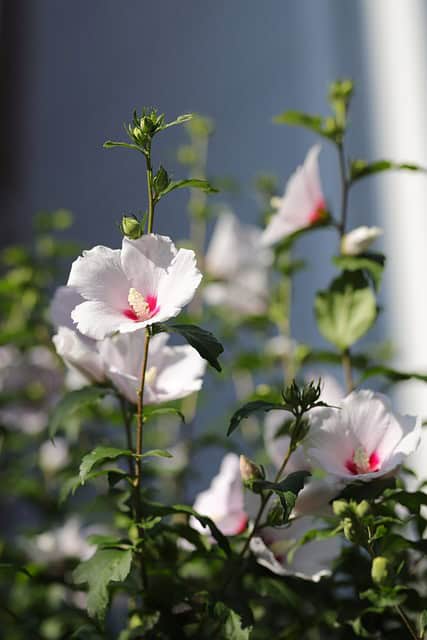
The Rose of Sharon (Hibiscus syriacus) is an iconic late summer bloomer, known for its large, showy blooms in various colors, including white, pink, lavender, and blue. This deciduous shrub often starts flowering in mid to late summer, adding lush color and a tropical vibe to gardens.
Rose of Sharon thrives in full sun and adapts easily to various soil conditions, showcasing its versatility as a landscape choice. It can also be shaped through pruning to maintain a manageable size and promote bushier growth. When planted strategically, this resilient shrub can create beautiful backdrops, provide privacy, or even become focal points in garden beds. The dramatic blooms attract pollinators like butterflies, encouraging biodiversity while wrapping up the summer with a spectacular visual display.
Helenium
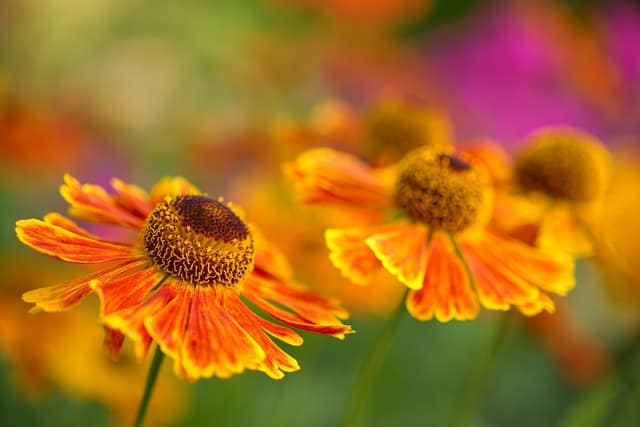
Helenium, commonly known as sneezeweed, adds fiery colors to late summer gardens with its warm hues of red, orange, and yellow. These hardy perennials bloom from July to September, creating a dynamic visual impact that can enliven any garden.
Although they flourish best in full sun, heleniums adapt to various soil conditions, making them valuable companions in mixed borders or cottage gardens. Regular deadheading encourages fresh blooms and keeps the plants tidy while maximizing their blooming period. These vibrant flowers are also excellent at attracting bees and butterflies, aiding pollination, and enhancing the aesthetics of your garden. By planting heleniums, you celebrate the splendor of late summer while enriching your landscape.
Blue Mist Shrub
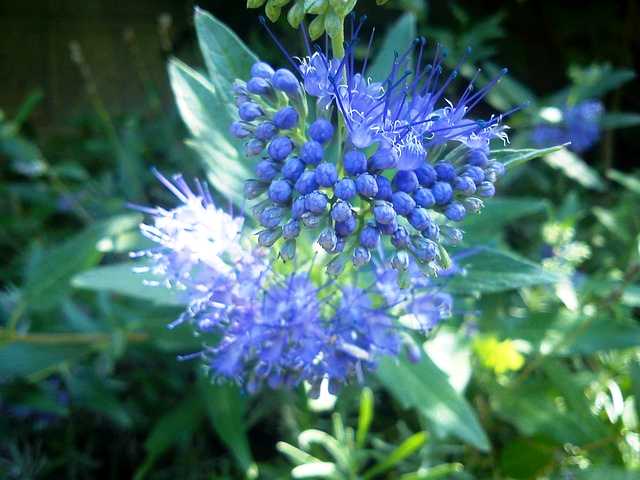
Blue Mist Shrub (Caryopteris) offers a delightful tapestry of color and texture late in summer, featuring stunning blue flowers and aromatic silver leaves. Often pivotal in pollinator gardens, the blooming season typically spans late summer into early fall, captivating bees and butterflies that flock to its blooms.
Thriving in full sun and well-draining soil, the blue mist shrub presents an eye-catching feature in gardens, whether as a standalone specimen or part of a broader planting scheme. Its compact growth habit allows it to thrive in smaller spaces, making it a fabulous choice for urban gardens or patios. The juxtaposition of its airy, delicate blooms with the tough, resilient habit encourages a sense of summer tranquility, bridging into the beautiful change of seasons.
Liatris
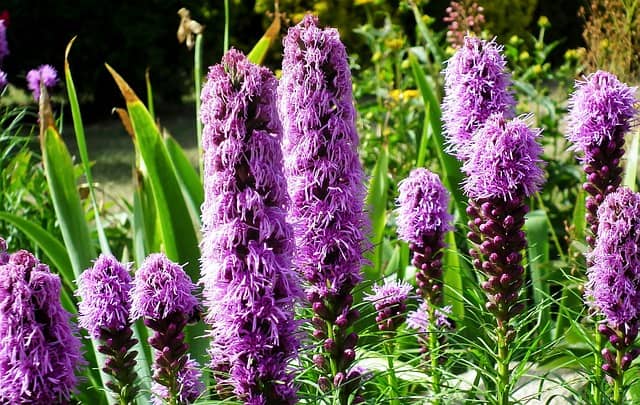
Liatris, or gayfeather, is known for its tall, spiky flower heads that bloom from the top down, creating vibrant clusters of purple and pink on slender stalks. With blooming periods extending from late summer into early fall, these hardy perennials create a striking vertical presence in any garden.
Well-suited for full sun and well-drained soil, liatris is a favorite among pollinators and will typically attract butterflies and bees to your garden. They make high-impact additions to perennial borders or wildflower gardens, providing visual diversity and motion as they sway delicately in the wind. The unique bloom structure and long-lasting floral display make liatris a staple for those looking to enjoy extended beauty in their late summer gardens.
Roses
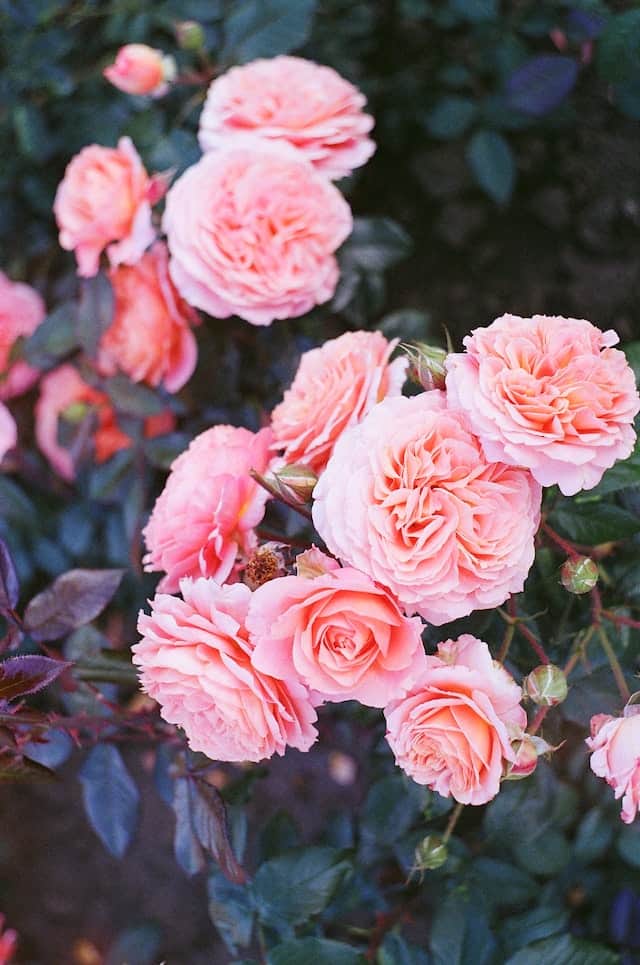
Roses, the beloved classic of gardens worldwide, bloom throughout the summer and continue their enchanting display well into late summer. With countless cultivars offering diverse colors, shapes, and scents, roses bring an element of romance and elegance to any garden.
Thriving in full sun and requiring well-drained soil, roses blossom best with proper care, including regular pruning, watering, and feeding. Many varieties exhibit reblooming capabilities, ensuring that your garden continues to showcase the rich visual allure of roses as summer fades. Their unmistakable fragrance and stunning beauty make them perennial favorites, fostering a sense of nostalgia and luxury in any landscape. By celebrating roses in late summer, you can embrace their beauty and timeless charm well into autumn.
Clematis
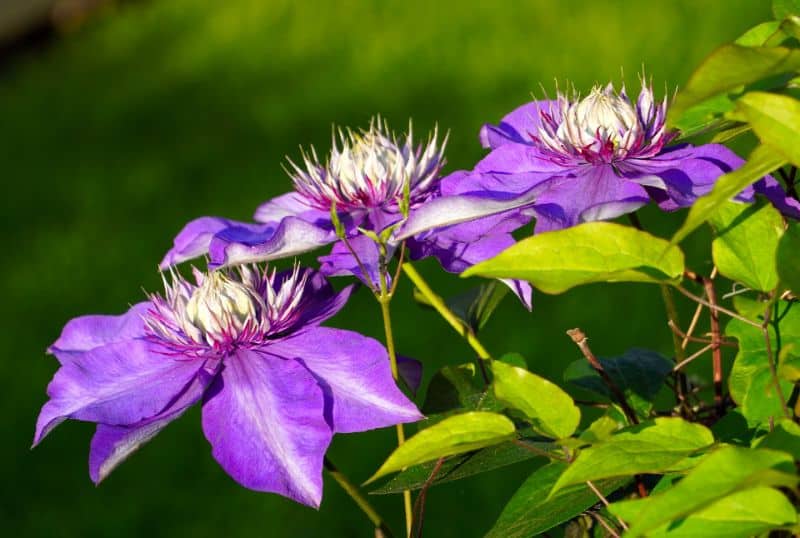
Clematis is a flowering vine known for its cascading blooms and lush foliage that thrives during late summer. Displaying a kaleidoscope of colors and shapes ranging from delicate pastels to bold dusky tones, clematis can add a vertical element that dresses up fences, trellises, and arbors.
Preferring full sun to partial shade and well-draining soils, these beautiful climbers can adapt to various environments, making them versatile additions to any garden. By selecting different cultivars, you can extend the bloom time, ensuring colorful displays from late summer through fall. The unique structure and vibrant blooms of clematis invite admiration and serve as striking green canopies, inviting exploration to any garden setting.
Zinnias
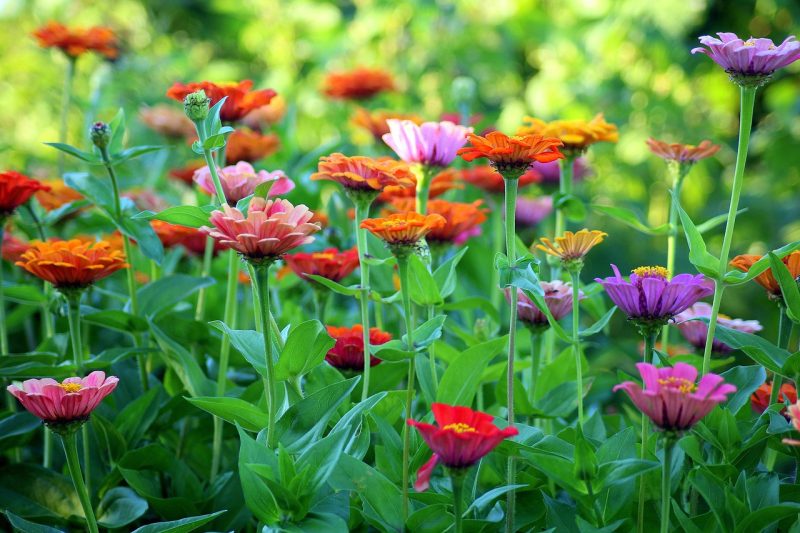
Zinnias are the epitome of summer vibrancy, bursting forth with vivid colors and a cheerful disposition well into late summer. These annuals are prized for their long-lasting blooms in nearly every color imaginable, creating an explosion of joy.
Zinnias are incredibly easy to grow, making them ideal for any gardener. They thrive in full sun and well-drained soils, producing flowers that can be cut and used for easy, long-lasting bouquets. Regular deadheading encourages prolonged blooming, ensuring that the party doesn’t stop until late fall. Their vibrant nature attracts butterflies and pollinators, serving as the finishing touch in a late summer garden filled with life and color.


